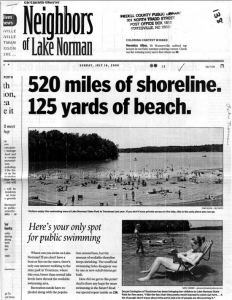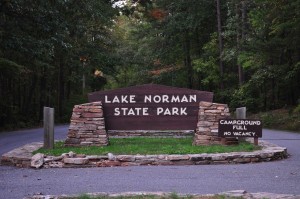Official Requirements
When Duke Energy decided to dam the Catawba River in 1963 for the generation of hydroelectric power and Lake Norman, there were many regulations the company had to abide by in order to develop the area. One of these guidelines, as stated by Federal Energy Regulatory Commission (FERC), “requires owners of licensed projects to allow reasonable public access and use of project lands and waters for recreation” (3). Duke donated 1328 acres of land in Iredell County for the creation of a state park as well as providing ten public access points for boating. Additionally, Duke Energy donated $2,000,000 for the impact of Lake Norman on North Carolina and South Carolina, in accordance with the Habitat Enhancement Fund. This money is used to fund projects that protect natural areas of the lake. Duke is also responsible for maintaining the natural shoreline of its public areas on the lake, including all of the islands.
Public Use
According to the General Development Plan for Lake Norman by the Charlotte-Mecklenburg Planning Commission in 1961-1962, trends demonstrated an increased demand for outdoor recreation such as “swimming, fishing, boating, water skiing, and skin diving” and existing resources were overcrowding (48). The Planning Commission denoted the “high per capita incomes” likely to relocate to the region, and their need for “recreational facilities” (53). This booklet advertises the creation of Lake Norman and its state park as necessary to increase supply of outdoor public recreational resources and satisfy the demands of the people.

The state park has been well-received and has undergone various changes over the years, appealing to the needs of its users. When it first opened in 1965, there was a small fee to use the swimming area and bathhouse and the park was only open during daylight hours. Now, most of the features of the park are free, including special educational programming put on by the park rangers. The park does require a fee for a camping permit. The state park offers the only public swimming access on the lake but does not offer lifeguards. There are no longer gates at the park entrance so that select areas can remain open to accommodate private residents living within the park boundaries, making the park more accessible time-wise. The park is constantly growing in size and creating new facilities and trails to attract more visitors. However, at times there has been limited funding and regional support for the park, limiting the resources that it can offer.
State Park
Duke Energy gave control of LNSP to the North Carolina State Park System soon after its creation, partly because the park posed a liability threat to the company (Church, unofficial). While Duke Energy still provides monetary aid, as required by FERC, most of the decisions are made by the NC State Park System. For example, a 2004 update to the swimming area was funded by the North Carolina Parks and Recreation Trust Fund (http://www.ncparks.gov/News/newsletter/stewards/May_2005.pdf).
Reading Between the Lines
While Duke Energy openly acknowledges donating land for a state park because of federal requirements, the company also points out that they provided more services than were required of them, including two extra access points. However, it is interesting to note that while Duke Energy claims that they were responding to an increased demand for access to more recreational opportunities and yet attendance of the park has not changed significantly since its opening in 1965. It was projected that 528,520 people visited the park in its inaugural year and current estimates fall just above 500,000 (Church, state park pamphlets). Since the number of visitors to the state park did not increase alongside with the population boom of the area in the 1990s, we wonder if LNSP was developed in the best interest of people in the area or if it was mean more to appease regulators and make up for flooding people’s land.Ultimately, Lake Norman is meant as a source of cooling and power generation and provides recreational opportunities, which are enhanced by LNSP, secondarily.
Additionally, the Charlotte-Mecklenburg Planning Commission highlights Duke Power’s generous donation of 1300 acres of land for the creation of the state park as the “only major public recreational facilities to be developed by governmental agencies” (54). However, this fact obstructs historical details, including that at this time Duke Power Company was the sole owner of the land encompassing the lake, and therefore the only actor capable of donating land for the purposes of a state park.
The Planning Commission’s 1961 predictions about the economic resources of future residents around the lake raises the questions, including: for whom does the lake serve? and for whom does the park serve? (Click here to read about LNSP’s location.)
